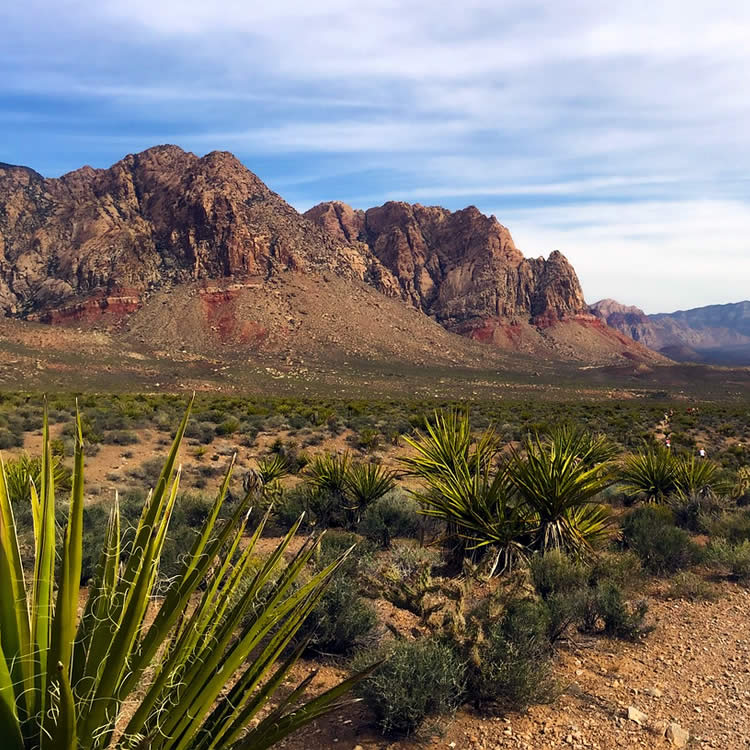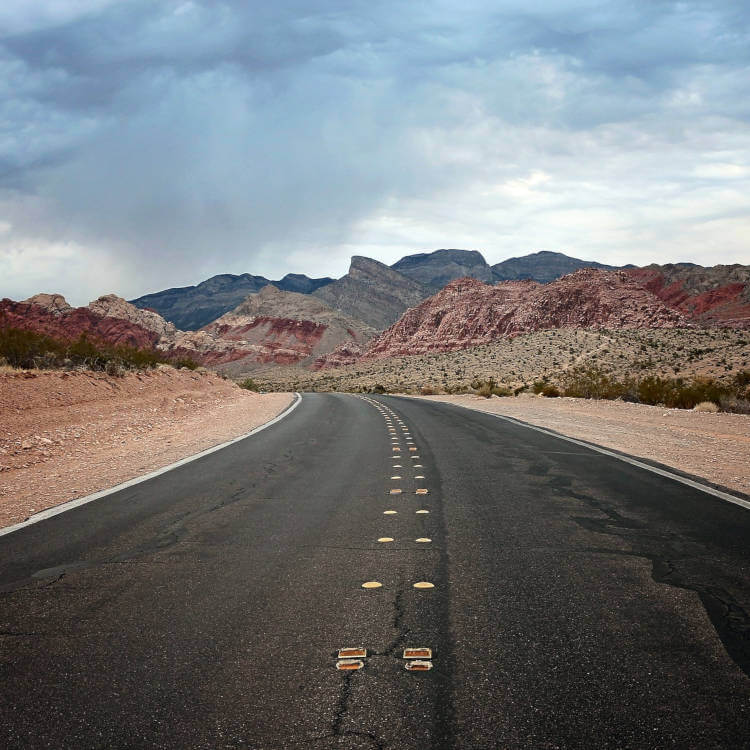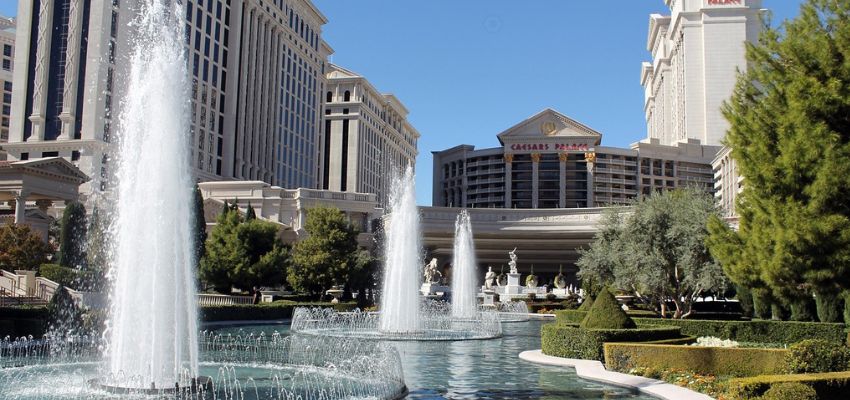The Pine Creek Canyon Trail begins at the Pine Creek parking lot along the Scenic Drive. See ponderosa pines, wildflowers, and Mojave desert shrubbery with views of the Rainbow Mountain Wilderness Area at the top of the trail.
How Far Is Red Rock Canyon From Las Vegas + 14 More Questions We Know You Have About Red Rock Canyon
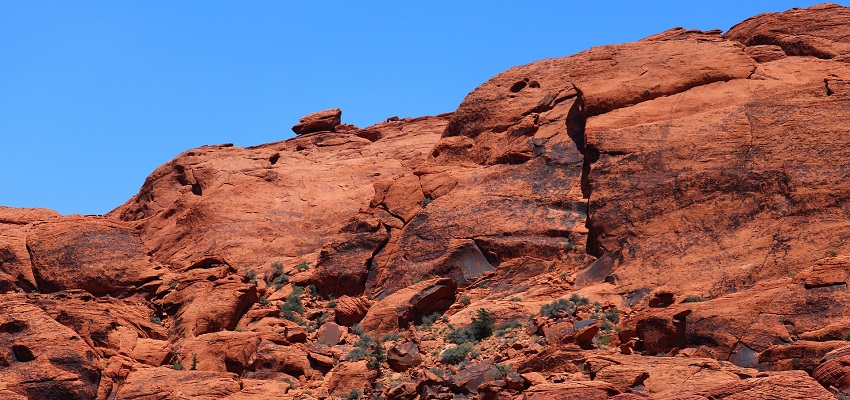
Red Rock Canyon is one of the most popular day trip destinations from Las Vegas—and for good reason. Its blazing red rock formations are iconic, there are numerous stunning viewpoints to explore, and it’s just a short 20 minute drive from the Strip.
Whether you’re thinking about adding a trip to Red Rock Canyon to your Vegas itinerary or you’re preparing for an upcoming adventure, we’ve compiled a list of 15 of the most commonly asked questions about Red Rock Canyon to help you plan your journey. In this post, we’ll answer:
- Where is Red Rock Canyon located?
- How big is Red Rock Canyon?
- Is Red Rock Canyon a National Park?
- How far is Red Rock Canyon from Las Vegas?
- How to get to Red Rock Canyon?
- What is the best time of year to visit Red Rock Canyon?
- How much does it cost to enter Red Rock Canyon?
- How long does it take to explore Red Rock Canyon?
- Are there any guided tours available at Red Rock Canyon?
- How was Red Rock Canyon formed?
- Why is Red Rock Canyon red?
- What are some of the geological features found in Red Rock Canyon?
- What are the best hiking trails in Red Rock Canyon?
- What animals can be seen in Red Rock Canyon?
- Can you camp overnight in Red Rock Canyon?
Let’s get started.
1. Where is Red Rock Canyon located?
Red Rock Canyon is located in Clark County Nevada, just a quick 20 minute drive from Las Vegas. It’s so close to Vegas you can actually see the Strip from some Red Rock Canyon viewpoints.
2. How big is Red Rock Canyon?
Red Rock Canyon covers an area of 197,349 acres—that’s roughly the size of 149,500 football fields, or 6 times the size of the island of Manhattan.
3. Is Red Rock Canyon a National Park?
No, Red Rock Canyon is not a National Park. Red Rock Canyon is a National Conservation Area—the first designated National Conservation Area in Nevada, in fact—and is managed by the Bureau of Land Management as part of the National Landscape Conservation System.
4. How far is Red Rock Canyon from Las Vegas?
Red Rock Canyon is about 20 miles from Las Vegas—about a 20-30 minute drive depending on traffic.
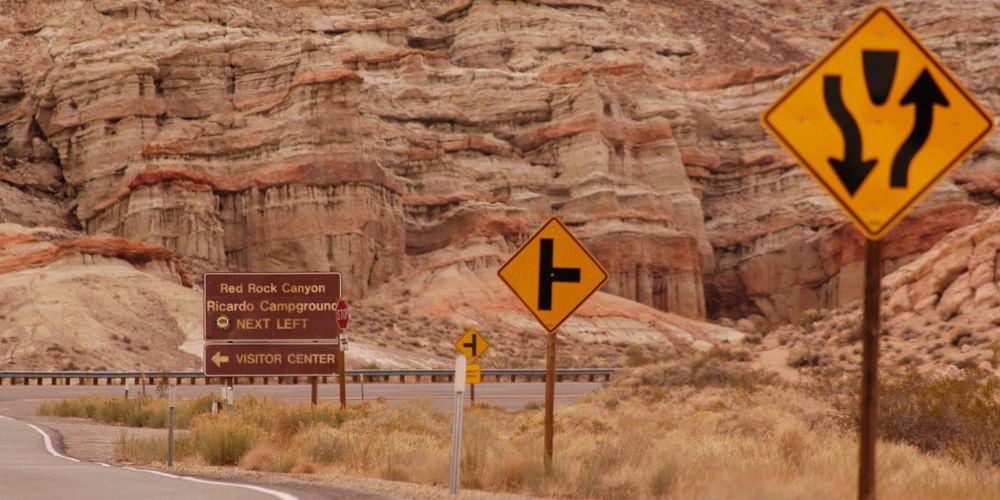
5. How do I get to Red Rock Canyon?
You can get to Red Rock Canyon easily by car. If you don’t have a car, you can hop on one of the many guided tours available from Las Vegas.
To get to Red Rock Canyon by car from the Strip and Downtown Las Vegas, you’ll drive along Charleston Boulevard, which will turn into SR 159 and lead you right to the park.
If you’re approaching from the south, take Blue Diamond Rd/SR 160 west to the Junction with Route 159. Follow SR 159 until you see the entrance signs
If you’re using a navigation system, use “1000 Scenic Loop Drive, Las Vegas, NV” as your address.
6. What is the best time of year to visit Red Rock Canyon?
The best time of year to visit Red Rock Canyon are the shoulder seasons—spring and fall—when temperatures are mild but comfortable with a relatively low chance of precipitation. Summers, on the other hand, are busy and temperatures can be scorching. If you plan to visit in June, July, or August, be sure to dress appropriately and bring lots of water. If you plan to visit in the winter, bring lots of layers.
|
Month |
Average High Temperature |
Average Precipitation |
|---|---|---|
|
January |
53.7°F / 12.1° C |
1.35 in / 3.5 cm |
|
February |
56.8°F / 13.8° C |
2.02 in / 5.1 cm |
|
March |
63.9°F / 17.7° C |
1.47 in / 3.7 cm |
|
April |
71.0°F / 21.7° C |
0.55 in / 1.4 cm |
|
May |
81.2°F / 27.3° C |
0.17 in / 0.40 cm |
|
June |
90.9°F / 32.7° C |
0.12 in / 0.30 cm |
|
July |
96.7°F / 35.9° C |
0.82 in / 2.1 cm |
|
August |
94.7°F / 34.8° C |
1.0 in / 2.5 cm |
|
September |
87.6°F / 30.9° C |
0.55 in / 1.4 cm |
|
October |
75.4°F / 24.1° C |
0.54 in / 1.4 cm |
|
November |
62.0°F / 16.7° C |
0.80 in / 2.0 cm |
|
December |
52.7°F / 11.5° C |
1.13 in / 2.9 cm |
7. How much does it cost to enter Red Rock Canyon?
The cost to enter Red Rock Canyon depends on the size of vehicle you’re entering in:
- Car or truck: $20/vehicle
- Motorcycle: $10/vehicle
- Bicycle: $8/bike
- Commercial tour vehicle: $20/vehicle + $5/person
You can also purchase an annual pass for $50.
For the most up to date admission fees, visit the Red Rock Canyon website.
8. How long does it take to explore Red Rock Canyon?
You can see Red Rock Canyon in a single day. If you just want to hit the Scenic Drive and don’t plan to get out and wander about, you can see Red Rock Canyon in as little as 45 minutes; however, we highly recommend you give yourself at least 1-2 hours to travel the Scenic Drive so that you can enjoy the stops along the way (there are 16 to choose from). Most visitors take between 2-4 hours to explore the area, including a stop at the visitor center, a few viewpoints, and a short hike.
9. Are there any guided tours available at Red Rock Canyon?
Yes, there are a number of companies that offer guided tours of Red Rock Canyon (including Canyon Tours!). Hiking tours, scooter tours, e-bike tours, helicopter tours, and SUV tours from Las Vegas.
10. How was Red Rock Canyon formed?
If you can believe it, 600 million years ago, the land that is now Red Rock Canyon was located at the bottom of a deep ocean. Marine life flourished, leaving behind large deposits of shells and skeletons more than 9,000 feet thick. Eventually, these deposits would be compressed into the limestone and carbonate rocks of Red Rock Canyon as we know it today. But how exactly did they get there?
About 225 million years ago, crustal movements caused the ocean seabed to slowly rise, and streams entering the shallower waters started depositing fresh mud and sand that later consolidated into shale and marine sandstone. These changing land and sea levels also trapped large bodies of water that later evaporated, leaving behind layers of salt and gypsum in some areas.
Fast forward to about 180 million years ago when a giant dune field stretched from present-day Red Rock Canyon eastward into Colorado. As the wind shifted the half-mile-deep dunes back and forth, old dunes were leveled and quickly replaced by new ones, resulting in the formation of curving, angled lines in the sand known as “crossbeds”. These shifting sands were buried by other sediments and eventually were cemented into sandstone by iron oxide and calcium carbonate. This formation, known locally as the Aztec Sandstone, forms many of the prominent cliffs of the Red Rock escarpment we see today.
11. Why is Red Rock Canyon red?
Red Rock Canyon is red because of the presence of iron oxide or hematite in the Aztec Sandstone. Exposure to the atmosphere causes the iron minerals in some areas to oxidize, giving the rocks their iconic red and orange coloring.
Areas where the rock is buff in color may be places where the iron has been leached out by subsurface water, or where the iron oxide was never deposited.
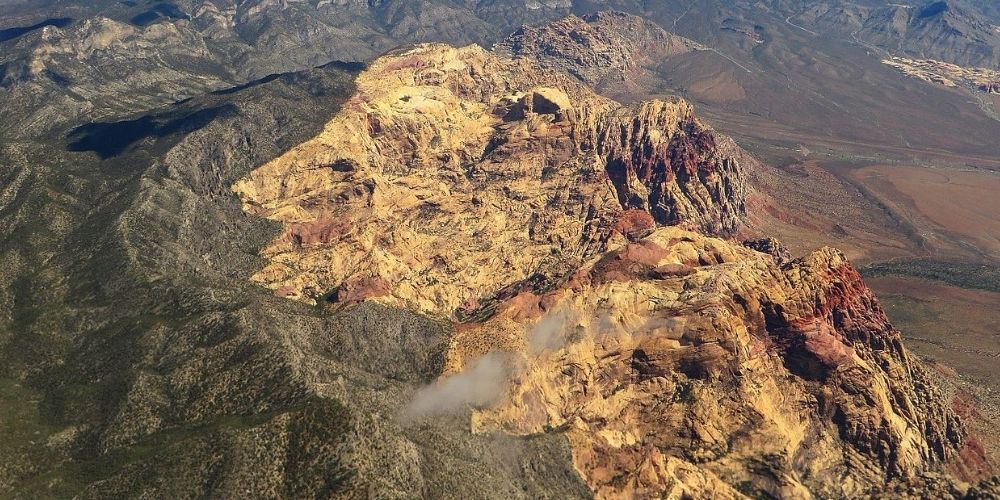
12. What are some of the geological features found in Red Rock Canyon?
The most significant geological feature or Red Rock Canyon is the Keystone Thrust Fault. The Keystone Thrust Fault is part of a large system of thrust faults that began forming 65 million years ago, extending all the way north into Canada.
GEOLOGY FACT: A thrust fault is a fracture in the earth’s crust caused by compressional forces that drive one crustal plate over the top of another. As a result, the oldest rocks on the bottom of the upper plate rest directly above the youngest rocks on the lower plate.
At Red Rock Canyon, the gray carbonate rocks of the ancient ocean were thrust over tan and red sandstone, creating one of the most dramatic and easily identified thrust faults in the country.
Other key geological features at Red Rock Canyon include:
- Calico Hills: Distinct crimson hills made of Red Rock Canyon’s iconic Aztec Sandstone.
- Ice Box Canyon: A cool, shady box canyon complete with seasonal waterfalls.
- Turtlehead Peak: Turtlehead Peak offers some of the most impressive views in the area—if you can handle the strenuous 4.6 mile uphill hike.
- Bridge Mountain: A peak of the Red Rock Escarpment featuring a naturally-formed arch that looks like a bridge.
- Mount Wilson: While not technically located within the conservation area, Mount Wilson is the highest peak among the Spring Mountains situated along Red Rock Canyon.
Read our guide to the best Red Rock Canyon viewpoints for more spots to see while you visit.
13. What are the best hiking trails in Red Rock Canyon?
There are 18 hiking trails to explore at Red Rock Canyon. We’ve compiled a list of six of our favorites, starting with the easiest trails, based on Alltrails ratings:
Children’s Discovery Trail and Lost Creek Canyon Trail
| Approx. Duration | 1 hour |
| Distance | 0.8 miles |
| Difficulty | Easy |
| Route Type | Loop |
| Obstacles | None |
| Elevation Gain | 98 feet |
With an easy-to-follow route, picturesque views, and petroglyphs, this trail is ideal for families with kids, or those looking for an easier hike. It’s accessible from the Scenic Drive, and if you visit between December and April, you’ll also see a waterfall.
White Rock Hills Loop
| Approx. Duration | 3 hours |
| Distance | 6 miles |
| Difficulty | Easy |
| Route Type | Loop |
| Obstacles | Limited shade (wear a hat and bring lots of water!) |
| Elevation Gain | 1,135 feet |
The White Rock Hills loop trail travels through open desert on mostly flat terrain, leading to views of White Rock Hills with petroglyphs along the way.
Pine Creek Canyon Trail
| Approx. Duration | 2.5 hours |
| Distance | 3.4 miles |
| Difficulty | Easy |
| Route Type | Out & back |
| Obstacles | Uneven terrain |
| Elevation Gain | 515 feet |
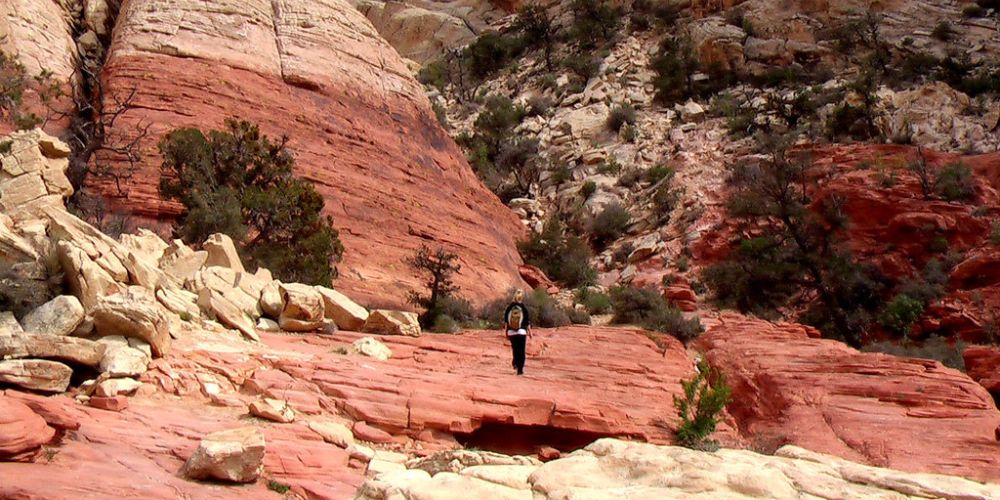
Calico Tanks Trail
| Approx. Duration | 2 hours |
| Distance | 2.2 miles |
| Difficulty | Moderate |
| Route Type | Out & back |
| Obstacles | Sandstone steps, uneven terrain |
| Elevation Gain | 406 feet |
The Calico Tanks Trail offers some of the best views of Red Rock Canyon. The trail begins at Sandstone Quarry and leads to a tank located in a natural catchment area, with some sandstone steps and scrambles along the way.
Calico Hills Trail
The Calico Hills Trail is one of the most popular trails at Red Rock Canyon, offering some of the best views of the red and orange landscape. The trail is super flexible—you can start at the visitor center or at the Calico I or Calico II parking lots, and you can also add the Calico Tanks Trail to the end of your hike if you want more of a challenge.
| Approx. Duration | 1.5-3.5 hours |
| Distance | 2-6.4 miles |
| Difficulty | Moderate |
| Route Type | Out & back |
| Obstacles | Scrambling |
| Elevation Gain | 1,108 feet |
Turtlehead Peak Trail
| Approx. Duration | 3.5-4.5 hours |
| Distance | 4.6 miles |
| Difficulty | Difficult |
| Route Type | Out & back |
| Obstacles | Elevation gain, slippery descent |
| Elevation Gain | 1,988 feet |
The Turtlehead Peak Trail is one of the hardest trails in the area, but it offers one of the biggest payoffs. The trailhead is located near the visitor center and continues upward on a steep, nearly 2,000 foot ascent. If you can handle it, you’ll be rewarded with sweeping views of the La Madre Mountains and Sandstone Quarry, and even all the way to the Vegas Strip. Note that it’s easy to lose your way on the official trail if you aren’t paying attention to the signs and markers.
14. What animals can be seen in Red Rock Canyon?
Red Rock Canyon is home to 38 species of mammals, 44 species of reptiles and amphibians, and 170 species of birds. Many mammals are nocturnal or are burrow-dwelling (an adaptation to the harsh desert climate) so you may not spot many while you visit, but here are some of Red Rock Canyon’s most famous inhabitants:
- Carnivores: They’ll be hard to spot during the day, but Red Rock Canyon is home to coyotes, kit foxes, gray foxes, bobcats, and mountain lions. (Don’t worry—Red Rock Canyon’s carnivore population is mostly nocturnal.)
- Small herbivores: Keep your eyes peeled for rodents, rabbits, and hares, such as the antelope ground squirrel, kangaroo rat, pack rat, blacktail jack rabbit, desert commontail. These small herbivores are often nocturnal as well, but antelope ground squirrel is most likely to be seen during the day.
- Large herbivores: Mule deer and desert bighorn sheep are most likely to be seen in foothills with low scrub or thick growth along washes, or on steep rocky terrain.
- Reptiles: The desert tortoise is most likely to be seen when emerging from burrows in late winter to early spring and in autumn to feed or mate, but they may be active in summer if temperatures are moderate enough. Lizards and other reptiles might be easier to spot in the daytime if you have a keen eye.
- Birds: Birders should keep their eyes peeled for cactus wrens, loggerhead shrikes, roadrunners, rufous-sided towhees, gambel’s quails, and more.
15. Can you camp overnight in Red Rock Canyon?
Yes, you can camp overnight in Red Rock Canyon, but the campground is not open year-round. Red Rock Canyon has one developed campground, but is closed during the hot summer months (typically between Memorial Day and September 1).
Drinking water is available, but the campground does not offer showers, electrical, water, or sewer hookups, or a dump station for recreational vehicles. Single and group campsites are available and must be reserved online. Backcountry camping is also permitted above 5,000 feet.
Wrapping Up
Just a short 20 minute drive from the Strip, Red Rock Canyon is one of the most popular day trip destinations from Las Vegas. With an iconic landscape known for its red and orange formations and numerous viewpoints and hiking trails, there is tons to do at Red Rock Canyon if you’re looking for an escape from the busy Strip.
Hop on our Red Rock Canyon tour and let us show you around:

